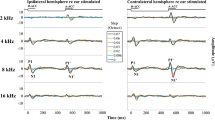Summary
The effects of a number of drugs on conditioned and unconditioned arousal responses (behavioural and electroencephalographic) produced by auditory stimuli in cats are reported. Positive conditioning was achieved by pairing certain auditory stimuli with a painful stimulus (electric shock).
Chlorpromazine increased thresholds for both conditioned and unconditioned stimuli and eventually blocked arousal responses completely. Reserpine, which had a delayed effect, caused only a slight rise in the conditioned response but blocked the unconditioned response although this latter effect may have been in part due to habituation.
Amphetamine caused a fall in the threshold for unconditioned arousal responses but did not change that for conditioned responses. However, these thresholds could no longer be assessed when doses which produced full alerting were used.
LSD 25 also caused a fall in the threshold for arousal to unconditioned stimulus and no change in the conditioned response, but it restored the response to a stimulus which had previously been habituated.
The results are discussed in relation to the hypothesis for the sites of action of these drugs in the brain which has been expounded previously.
Similar content being viewed by others
References
Ader, R., and D. W. Clink: Effects of chlorpromazine on the acquisition and extinction of an avoidance response in the rat. J. Pharmacol. 121, 144–148 (1957).
Adey, W. R., J. P. Segundo and R. B. Livingston: Corticofugal influences on intrinsic brain stem conduction in the cat and monkey. J. Neurophysiol. 20, 1–17 (1957).
Bradley, P. B.: Microelectrode approach to the neuropharmacology of the reticular formation. Psychotropic drugs, p. 207–216, S. Garattini and V. Ghetti (eds). Amsterdam: Elsevier Publ. Co. 1957.
Bradley, P. B., and J. Elkes: A technique for recording the electrical activity of the brain in the conscious animal. Electroenceph. clin. Neurophysiol. 5, 451–456 (1953).
Bradley, P. B., and J. Elkes: The effects of some drugs on the electrical activity of the brain. Brain 80, 77–117 (1957).
Bradley, P. B., and A. J. Hance: The effect of chlorpromazine and methopromazine on the electrical activity of the brain in the cat. Electroenceph. clin. Neurophysiol. 9, 191–215 (1957).
Bradley, P. B., and B. J. Key: The effect of drugs on arousal responses produced by electrical stimulation of the reticular formation of the brain. Electroenceph. clin. Neurophysiol. 10, 97–110 (1958).
Bradley, P. B., and B. J. Key: A comparative study of the effects of drugs on the arousal systems of the brain. Brit. J. Pharmacol. 14, 340–349 (1959).
Bremer, F.: Nouvelles recherches sur le méchanisme du sommeil. C. R. Soc. Biol. (Paris) 122, 460–464 (1936).
Cook, L., and E. F. Weidley: Behavioural effects of some psychopharmacological agents. Ann. N. Y. Acad. Sci. 66, 740–752 (1957).
Cook, L., E. F. Weidley, R. W. Morris and P. A. Mattis: Neuropharmacological and behavioural effects of chlorpromazine (Thorazine hydrochloride). J. Pharmacol. 113, 11 (1955).
French, J. D., R. Hernandez-Peon and R. B. Livingston: Projections from cortex to cephalic brain stem (reticular formation) in monkey. J. Neurophysiol. 18, 74–95 (1955).
Hance, A. J.: Studies on the effects of drugs on the electrical activity of the brain and on behaviour. Ph. D. Thesis, University of Birmingham 1956.
Hess, R., W. P. Koella and K. Akert: Cortical and subcortical recordings in natural and artificially induced sleep in cats. Electroenceph. clin. Neurophysiol. 5, 75–90 (1953).
Key, B. J., and P. B. Bradley: Effects of drugs on conditioning and habituation to arousal stimuli in animals. Nature (Lond.) 182, 1517–1519 (1958).
Rowland, V.: Differential electroencephalographic response to conditioned auditory stimulus in arousal from sleep. Electroenceph. clin. Neurophysiol. 9, 585–594 (1957).
Schneider, J. A., A. J. Plummer, A. E. Earl and R. Gaunt: Neuropharmacological aspects of reserpine. Ann. N.Y. Acad. Sci. 61, 17–26 (1955).
Sharpless, S., and H. Jasper: Habituation of the arousal reaction. Brain 79, 655–679 (1956).
Smith, R. P., A. I. Wagman, W. Wagman, C. C. Pfeiffer and A. J. Riopelle: Effects of some tranquillising and depressant drugs on conditioned avoidance behaviour in monkeys. J. Pharmacol. 119, 317–323 (1957).
Weisskrantz, L., and W. A. Wilson: The effects of reserpine on emotional behaviour of normal and brain-operated monkeys. Ann. N.Y. Acad. Sci. 61, 36–55 (1955).
Author information
Authors and Affiliations
Additional information
This work has been sponsored by the Office of Scientific Research of the Air Research and Development Command, United States Air Force, Contract No. AF 61 (514)-1184.
Rights and permissions
About this article
Cite this article
Key, B.J., Bradley, P.B. The effects of drugs on conditioning and habituation to arousal stimuli in animals. Psychopharmacologia 1, 450–462 (1960). https://doi.org/10.1007/BF00429270
Received:
Issue Date:
DOI: https://doi.org/10.1007/BF00429270



